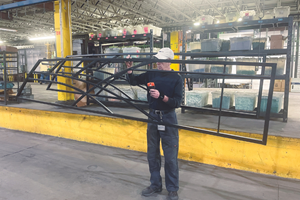Calculating Oven Heat Load Capacity
Please explain how to calculate the heat load capacity of a paint baking oven, using aluminum alloy wheels as an example.
Q. Please explain how to calculate the heat load capacity of a paint baking oven, using aluminum alloy wheels as an example. H.T.
A. Energy consumption in an oven is primarily related to radiant loss through the oven panels; energy required to raise the product, racks and conveyor to temperature; and exhaust losses. To determine the energy use, you will need to calculate these three factors and then add them to get the total.
Panel Loss
To calculate the loss of Btu/h through the oven panels, multiply the total square feet of oven panel surface area by the panel loss factor (see table) and then by the temperature difference between the oven start-up and the controller setting.
| Panel Thickness | Loss Factor |
|---|---|
| 3 inches | 0.40 |
| 4 inches | 0.35 |
| 5 inches | 0.30 |
| 6 inches |
0.25 |
| 8 inches | 0.20 |
Formula: Square feet of oven surface × panel loss factor × temperature rise
Example
Oven Size: 20 × 50 × 10 ft (W × L × H)
Operating Temperature: 300°F
Oven Start-up Temperature: 70°F
Panel Thickness: 4 inches
Oven Surface Area
Sides: 10 × 50 = 500 × 2 sides = 1,000
Ends: 10 × 20 = 200 × 2 ends = 400
Top and bottom: 20 × 50 = 1,000 × 2 = 2,000
Total: 1,000 + 400 + 2,000 = 3,400 sq ft
Temperature Rise
300°F - 70°F = 230°F
Panel Loss
3,400 sq ft surface area × 0.35 panel loss factor × 230°F temperature rise = 273,700 Btu/hr
Product Loading
To calculate the Btu/hr required to support the product loading, multiply the total load (parts, rack, conveyor chain and trolleys) by the specific heat (Btu required per lb °F) by the temperature rise. The factor 0.226 is used for aluminum. Different materials will require a different multiplier, and the table below shows the specific heat values for different metals.
| Metal | Specific Heat |
|---|---|
| Steel | 0.12 |
| Aluminum | 0.226 |
| Iron | 0.175 |
| Zinc | 0.0931 |
| Conveyor | Chain Weight/Ft | Trolley Weight |
|---|---|---|
| Enclosed Track | 3.5 lbs | 0.5 lbs (H-Attach) |
| X348 | 2.14 lbs | 2.34 lbs |
| X458 | 3.14 lbs | 5.18 lbs |
| X678 | 6.39 lbs | 16.5 lbs |
Formula: Total load × specific heat × temperature rise
Example:
Chain: X348
Trolley Centers: 12 inches
Racks: 5 lbs on 12-inch centers
Parts: 5 lbs on 12-inch centers
Line Speed: 10 ft/min
Oven Temperature: 300°F
Oven Start-up Temperature: 70°F
Total Load
Chain Weight: 2.14 + 2.34 = 4.48 lbs/ft
Parts and Racks Load: 5 + 5 = 10 lbs/ft
Total: 4.48 lbs chain and trolleys + 10 lbs parts and racks = 14.48 lbs/ft
Total product load/min: 14.48 lbs/ft × 10 ft/min = 144.8 lbs/min
Product load/hr: 144.8 lbs/min × 60 min = 8,688 lbs/hr
Temperature Rise
300°F - 70°F = 230°F
Btu/Hr
8,688 lbs/hr total load × 0.12 specific heat × 230°F temperature rise = 239,789 Btu/hr
(0.12 is the multiplier used for steel.)
Exhaust Loss
The exhaust loss is determined by multiplying the cu ft/min of exhaust (cfm) by 60 min by 0.075 lbs/cu ft by 0.24 Btu/hr per pound by the temperature rise in °F.
Formula: cfm × 60 × 0.075 × 0.24 × temperature rise
Example:
Exhaust Volume: 2,000 cfm
Set Temperature: 300°F
Oven Start-up Temperature: 70°F
Temperature Rise
300°F - 70°F = 230°F
Exhaust Loss
2,000 cfm × 60 min × 0.075 lbs/cu ft × 0.24 Btu/hr × 230°F temperature rise = 496,800 Btu/hr
Total Energy Use
To determine the total Btu/hr consumed, add the three factors: panel loss, product loading and exhaust loss. In the above examples, this total would be:
273,7000 + 239,789 + 496,800 = 1,010,289 Btu/hr
To determine the actual cost, you must multiply the consumption by the cost for the energy used in the oven. The cost for energy varies widely in different regions. It was an average of about $2.80 per million Btu the week ending August 15, 2012.
Related Content
The Lowdown on Infrared Curing
In this Q&A, infrared curing’s ins and outs are covered by Carlisle Fluid Technologies, including how it works, why its a popular curing type and the benefits of it.
Read MoreCuring Oven Basics
Simply heating up the substrate does not cure the coating. There are many variables to consider when choosing the best cure oven for your application...
Read More5 Maintenance Tips for Gas Catalytic IR Ovens
Basic and periodic preventive maintenance is essential for avoiding oven downtime.
Read MorePowder Coating Overcomes Post Forming
Six Sigma methodology, open communication, and collaboration produce results for leading boat manufacturer.
Read MoreRead Next
Education Bringing Cleaning to Machining
Debuting new speakers and cleaning technology content during this half-day workshop co-located with IMTS 2024.
Read MoreA ‘Clean’ Agenda Offers Unique Presentations in Chicago
The 2024 Parts Cleaning Conference, co-located with the International Manufacturing Technology Show, includes presentations by several speakers who are new to the conference and topics that have not been covered in past editions of this event.
Read MoreDelivering Increased Benefits to Greenhouse Films
Baystar's Borstar technology is helping customers deliver better, more reliable production methods to greenhouse agriculture.
Read More






















